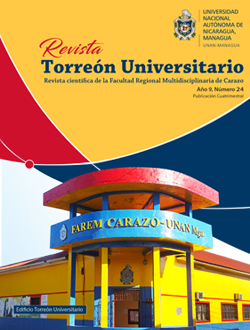Evaluation of the efficiency of arsenic removal in water with activated carbon from jícaro sabanero (Crescentia alata) and its combination with iron oxides
DOI:
https://doi.org/10.5377/torreon.v9i24.9724Keywords:
arsenic, activated carbon, iron oxides, removalAbstract
According to the World Health Organization, arsenic is one of the most dangerous chemicals in the world, due to its potential of causing a wide variety of diseases since diabetes until lung and skin cancers, among others. Therefore, it is important to develop techniques to remove it from drinking water. This study evaluated the arsenic removal efficiency from water using two sorbent media, iron oxides and artisanal activated carbon, in experiments conducted by duplicate for carbon and by triplicate for the sequential treatment iron oxides-carbon. The assays were carried out using activated carbon with two particles size of (2-4 and 0,6 mm) and two contact times (6 and 12 h) to treat samples spiked with three working concentrations (10, 25 and 50 μg As/L). The analysis of the remaining arsenic in water were carried out using the international standard methodology, atomic absorption using the technique of hydrides generation. The highest arsenic removal efficiencies were achieved with the sequential treatment iron oxides-activated carbon: 54, 50 and 58 %, respectively, for the three assayed concentrations. The analysis of variance did not find significant differences between contact time (6 and 12 h), but between particles size of activated carbon. Due to these findings it is recommended to use the shortest contact time (6 h) and the smallest particles size of activated carbon (0.6 mm) for arsenic removal.
Downloads
Downloads
Published
How to Cite
Issue
Section
License
Los autores que publican en esta revista están de acuerdo con los siguientes términos.
- El autor o los autores de los artículos, ensayos o investigaciones conceden a la Universidad Nacional Autónoma de Nicaragua, Managua (UNAN-Managua) los derechos de edición (copyright) del trabajo enviado, por consiguiente la Universidad cuenta con el derecho exclusivo para publicar el artículo durante el periodo completo de los derechos de autor.
- Estos derechos de autor/ autores autorizan a la Revista Torreón Universitario y a la Universidad editar y divulgar/publicar el artículo en dicha Revista, incluyendo reproducción impresa y electrónica, el almacenamiento, recuperación y cualquier otro tipo de publicación, y fuentes de información secundaria como servicios de resúmenes y bases de datos, así mismo la facultan a proteger el artículo contra el uso no autorizado para su difusión por medios impresos o electrónicos (PDF, HTML, EPUB, XML u otros).
Licencia para el uso del contenido
La revista hace uso de la Licencia Creative Commons Atribución-NoComercial-SinDerivar 4.0 Internacional.
Bajo esta declaración:

Este revista está sujeta a una licencia de Creative Commons Reconocimiento-NoComercial-SinObraDerivada 4.0 Internacional. Puede ser copiada, distribuida y transmitida públicamente siempre y cuando se cite al autor y la fuente (Revista Torreón Universitario), no debe modificarse ni utilizarse con ningún fin comercial. La licencia completa se puede consultar en http://creativecommons.org/licenses/by-nc-nd/4.0/.

